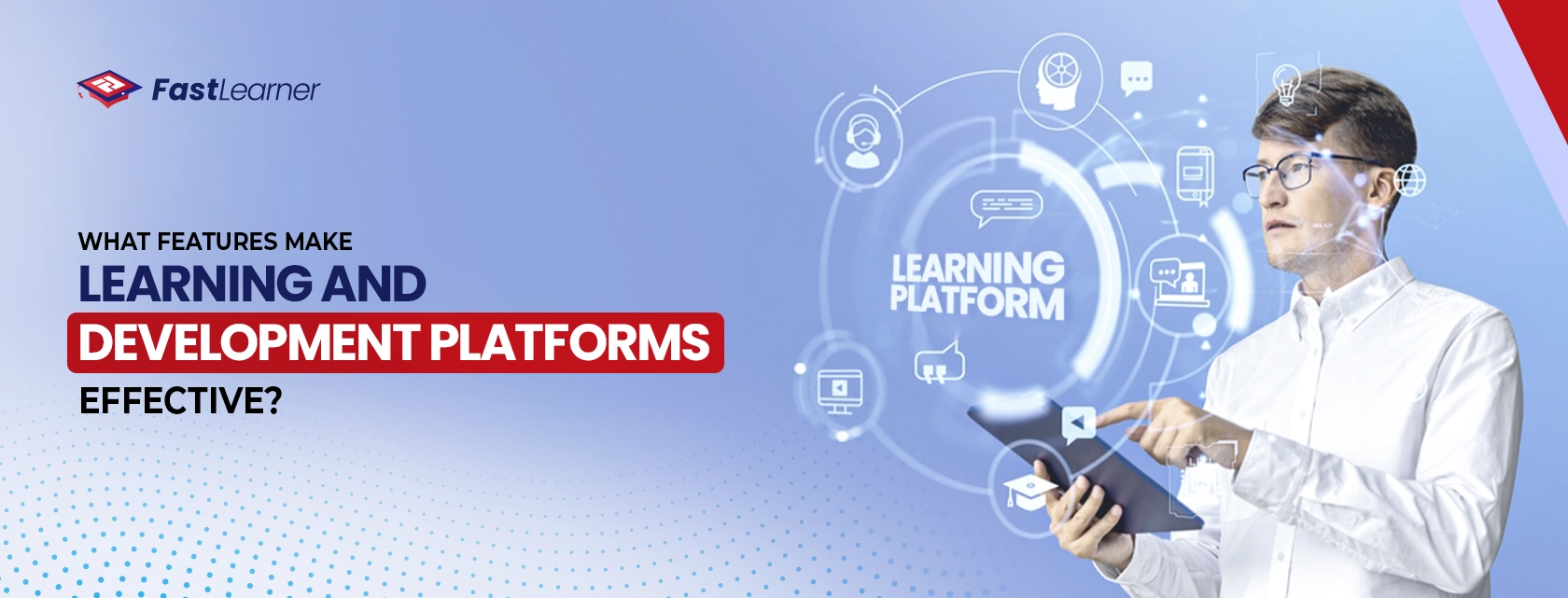In today’s fast-paced world, learning and development platforms have become essential tools for individuals and organizations seeking to stay competitive and relevant. These platforms, often called virtual learning platforms, offer users the ability to learn new skills online, access professional development courses, and continuously upskill. However, not all platforms are created equal.
So, what makes a platform truly effective for learners? Understanding the critical features of online learning that enhance the user experience can make all the difference between a mediocre platform and a powerful tool for transformation.
Learning and Development Platforms (An Overview)
- Effective learning platforms integrate critical elements that enhance user experience and foster successful online education.
- Intuitive design and mobile-friendly access are vital in creating engaging learning environments.
- Tailored educational paths are crucial for meeting individual learning preferences and professional aspirations.
- Interactive materials and collaborative features promote motivation and enrich the learning experience.
- Access to knowledgeable instructors and achievement tracking boosts learners’ confidence and career opportunities.
10 Features That Makes Learning and Development Platforms More Effective?
1. User-Centric Design for a Great Learning Environment

One key feature that defines the success of learning and development platforms is their ability to create an intuitive and seamless user experience. A platform with a clean, easy-to-navigate interface fosters an effective learning environment by minimizing distractions and allowing learners to focus on the content. The design should cater to both novice and experienced users, making it accessible to a wide range of learners.
An effective platform should also be mobile-friendly to support an excellent student learning environment. This ensures learners can access the content whenever and wherever they are, promoting flexibility in their study habits. A well-designed interface combined with cross-device compatibility enhances user engagement and satisfaction, ultimately improving learning outcomes.
2. Personalized Learning Paths and Content Curation

A standout feature of top learning and development platforms is the ability to offer personalized learning paths tailored to each learner’s needs. This is especially important as learners have different backgrounds, goals, and learning styles. Customized learning paths ensure individuals consume content relevant to their career or personal development goals.
Companies increasingly invest in training their employees to utilize AI tools effectively to boost productivity. As a result, 83% of businesses now identify AI as a top priority in their strategic plans.
Content curation is another aspect that adds value to platforms. Users should be able to choose from various things to learn online, ranging from technical skills like coding and data analysis to soft skills like communication and leadership. By aligning the learning material with each user’s preferences and goals, platforms increase the likelihood of knowledge retention and application in real-life scenarios. For more insights, check out our article on How to Use AI Tools for Learning and Development.
3. Diverse Course Selection to Cater to Various Interests

A robust course library is another crucial component of successful online studying platforms. The best platforms offer diverse topics that allow users to explore different fields or deepen their expertise in a particular area. The availability of various courses encourages continuous learning and skill development.
For example, on FastLearner.ai, some individuals may focus on enhancing their professional skills, such as data science or business strategy. In contrast, others may explore things to learn online, like digital marketing or AI-powered tools. By offering a diverse range of subjects tailored to different career paths and personal interests, FastLearner.ai caters to the unique learning needs of its users, making the platform versatile and appealing to a broad audience.
4. Interactive and Engaging Learning Materials

Static content can quickly become dull and disengaging. The most effective virtual learning platforms incorporate interactive elements that keep learners engaged and motivated. Features such as quizzes, interactive videos, discussion forums, and real-time feedback mechanisms encourage active participation and allow learners to test their understanding in real-time.
Gamification, another engaging feature, adds an element of fun by incorporating points, badges, or certificates based on achievements. Not only does this make learning more enjoyable, but it also fosters a sense of accomplishment, motivating users to complete their courses.
5. AI-Driven Features for Tailored Recommendations

As more learning and development platforms embrace AI technology, they become more innovative in delivering content to users. AI can analyze user behavior, preferences, and progress to recommend personalized courses, ensuring learners are continually engaged with relevant material.
AI also monitors learner progress and identifies areas where additional support may be needed. By tailoring course suggestions and helping users stay on track, AI-driven features create a great learning environment for students, young adults, and business individuals that supports individual growth and skill mastery.
6. Collaboration and Community Building for Social Learning

One often overlooked feature of successful skill-learning platforms is their ability to foster community and user collaboration. Social learning, which involves learning from peers through discussion and collaboration, can significantly enhance the learning experience.
Platforms that include discussion boards, peer reviews, group projects, or networking opportunities allow learners to engage with others and share insights. This enhances knowledge exchange and helps users build a support system. A strong sense of community can motivate learners to stay committed to their goals and improve their overall experience on the platform.
7. Access to Expert Instructors and Mentorship Programs

The quality of its instructors also determines the effectiveness of a learning platform. Top online studying platforms offer courses taught by industry experts who provide valuable insights and real-world examples. Access to experienced instructors can significantly enhance learning outcomes as learners gain practical knowledge that they can apply immediately in their careers or personal projects.
Mentorship programs are another valuable feature, allowing learners to connect with professionals in their field for one-on-one guidance. This personalized support can accelerate learning and help individuals navigate career paths confidently.
8. Progress Tracking and Certification
Learners want to see tangible proof of their progress. Effective learning and development platforms offer comprehensive progress-tracking features that allow users to monitor their achievements and identify areas for improvement. Whether tracking course completion, quiz scores, or skill assessments, progress-tracking tools help users stay motivated and focused on their goals.
Certification upon course completion is another key feature. Receiving a certificate not only provides a sense of accomplishment but also serves as verifiable proof of a learner’s skills. These certifications can be shared on professional networks like LinkedIn, adding value to a learner’s career prospects.
9. Flexible Learning Schedules for Busy Individuals

One of the primary reasons individuals turn to virtual learning platforms is the flexibility they offer. Learners should be able to start, pause, and resume their courses according to their schedules. This flexibility is essential for working professionals, parents, or anyone with a busy lifestyle who may find it challenging to adhere to a rigid learning schedule.
Compelling features of e-learning include asynchronous learning options, allowing users to access pre-recorded lectures, tutorials, and assignments at their own pace. This flexibility enables learners to integrate education into everyday life without feeling overwhelmed or pressured by deadlines.
10. Affordable and Scalable Learning Opportunities

Affordability is a significant concern for many learners, and effective platforms often offer a range of pricing options to cater to different budgets. Many online studying platforms use a subscription-based model, while others may offer one-time payments for specific courses. Providing free courses or trials also makes learning accessible to a broader audience.
Scalability is equally important, particularly for organizations looking to upskill their workforce. The ability to scale courses and customize employee training makes these platforms invaluable for corporate learning and development programs.
Conclusion: Building an Effective Learning Platform
An effective learning and development platform combines a user-friendly interface, personalized learning paths, diverse course options, engaging content, and robust community features. What features make learning and development platforms effective? It supports flexibility, scalability, and affordability, making it accessible to many learners.
Ultimately, the best skill-learning platforms provide an immersive and supportive environment where individuals can continually learn new skills online, track their progress, and earn certifications that advance their personal and professional growth. By focusing on these essential features, a platform can create an effective learning environment that empowers users to achieve their full potential.
FAQs About Learning and Development Platforms
What are the best features of an online learning platform?
The best features of an online learning platform include user-friendly design, personalized learning paths, diverse course offerings, interactive learning materials, AI-driven recommendations, community and collaboration tools, access to expert instructors, progress tracking, certification options, and flexible learning schedules.
What are the features of LMS that make them great?
Great Learning Management Systems (LMS) offer intuitive interfaces, mobile accessibility, robust analytics and reporting, customizable course content, gamification elements, social learning capabilities, practical communication tools, integration with other software, and scalable pricing models to cater to different audiences.
Which of the following can be said to be key features of a successful LMS?
Key features of a successful LMS include personalized learning experiences, interactive content, user engagement tools, progress tracking and certification upon completion, mobile compatibility, and strong support for collaboration among learners.
What is a learning and development platform?
A learning and development (L&D) platform is a digital tool designed to facilitate acquiring new skills and knowledge through online courses, training programs, and resources. These platforms cater to individual learners and organizations, enabling continuous professional development and personal growth.
What is an L&D strategy?
An L&D strategy is a comprehensive plan that outlines how an organization will invest in employee training and development. This strategy typically includes identifying learning needs, setting objectives, selecting appropriate learning methods and technologies, measuring outcomes, and ensuring alignment with organizational goals.
What is the purpose of a learning platform?
A learning platform provides a structured environment where users can access educational resources, engage in interactive learning, track progress, and earn certifications. These platforms support skill development, enhance knowledge retention, and enable continuous learning for personal and professional growth.



